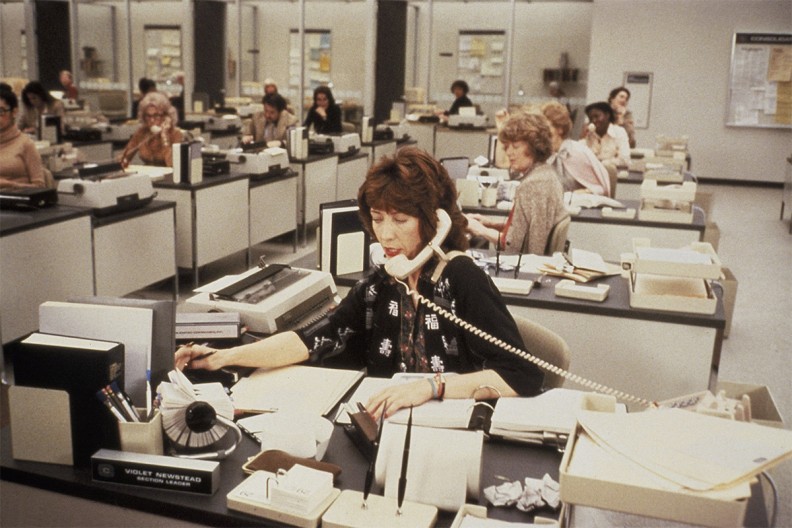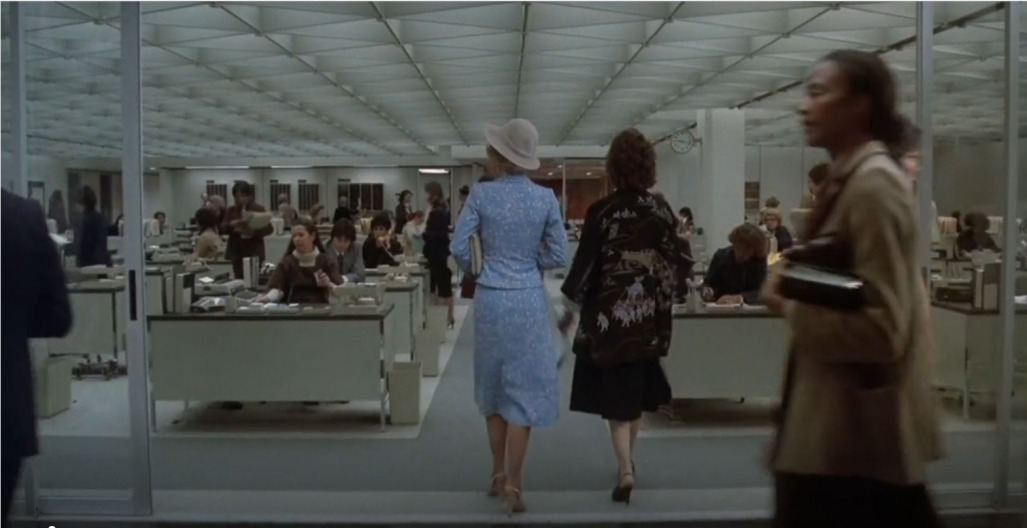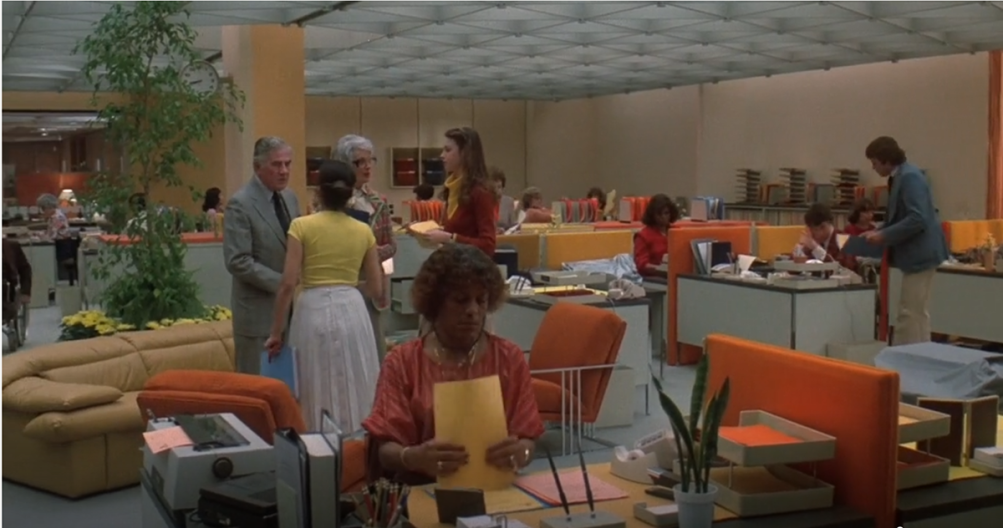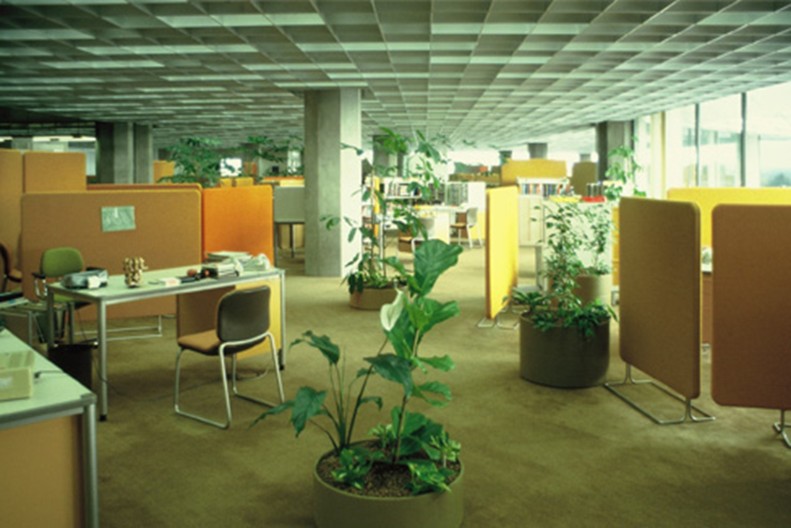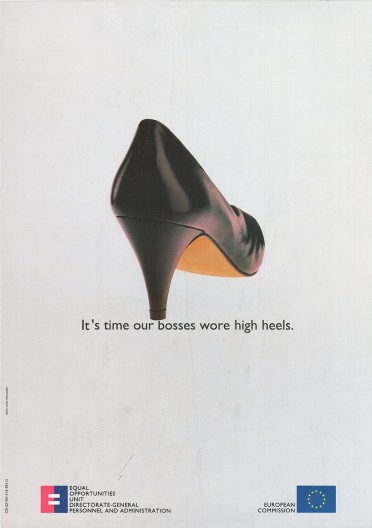The doors of a lift open and a storm of faceless women pour out and head to their desks. They effortlessly remove the cloths covering their typewriters and begin their working day. The camera moves to reveal an endless string of white-collar female workers. Soon the scene gets more chaotic. Folders are moved around, coffee is prepared, drawers packed with documents are slammed, there are images of telephones, workstations, early computers: an office safari!
As much as I would like to claim this as the first visual contribution to the BUREU research project, what I have just described is actually the trailer for the iconic film 9 to 5 (1980). In this hit comedy, starring Lily Tomlin, Dolly Parton and Jane Fonda, director Colin Higgins follows three female office workers who kidnap their abusive boss and start a workplace revolution.
While the entertainment value of the film is indisputable, I would argue that it is also useful as a narrative tool in a visual analysis of office planning techniques and managerial norms. Furthermore, it shows “the office” as a microcosm of broader cultural and political phenomena.
For political activist and women’s rights advocate Jane Fonda, the office actually proved to be a key site for exposing women’s everyday struggles. She had come across the reality of women’s situations through real-life accounts of abuse and injustice from members of the Association 9to5, a movement that since 1973 has been fighting to empower women in the workplace.
As pointed out in this blog’s previous post, office buildings are not simply “neutral shells” for political and administrative activities. In the case of the film, they prove to be spaces for political action and women’s liberation.
Once the boss has been kidnapped, the women – who in the first part of the film are shown struggling with the office design and rules – end up gradually appropriating the space by changing it in order to reflect the “new order” and break away from gendered managerial practices.
For example, at first, personal items such as plants, pictures or any kind of office decor are not allowed because the office should not look cluttered or sloppy. As the floor supervisor proudly explains: “An office that looks efficient is efficient!” In reaction, the first resolution of the “new administration” is to allow all these personal objects to be seen. As they gain control of the office, the working space comes to reflect their own values and desires. In line with what Varda Wasserman (The Gendered Aesthetics of the Physical Environment, 2019) has identified as women workers’ need to appropriate the male-controlled and male-conceived office space, the employees in 9 to 5 turn it into a place of their own.
Another example of space appropriation is directly related to office planning. Although the office floor is initially planned based on a traditional large “open” typing pool layout – complete with grey, aseptic furniture –, the situation is completely different when the boss returns. Workstations are positioned “organically” across the office floor and desks are separated from one another with small partitions and plants. The layout seems to come straight out of the sketchbook of the Quickborner team. Established in 1958 by Wolfgang and Eberhard Schnelle, the Quickborner consultancy firm created the revolutionary “office landscape” concept (Bürolandschaft). The bright colours and design of the furniture, moreover, recall another influential innovation in office design: Robert Propst’s Action Office equipment, designed for the Herman Miller company during the 1960s.
Both the Bürolandschaft and the Action Office design were conceived to challenge the traditional Taylorist approach to office space organisation and its concept of efficiency. However, the new approaches from the 1960s eventually degenerated into the rigorous multitude of cubicles so typical of modern offices. The very flexibility of these innovations buckled under the weight of the profit motive, with company owners choosing to maximise profits by cramming as many workers as possible into a limited space.
Interestingly, the film also explores the legitimacy of these spatial choices in relation to efficiency. The closing scenes see the chairman of the company coming to check out the office premises, since the company actually achieved a 20% rise in productivity during the period in which the women had taken over.
As argued, the film proves the validity of offices as an example of “lived space”. A notion originally introduced by Henri Lefebvre in The Production of Space (1974), a “lived space” is one in which users, through their everyday practices and relationships, actively shape the space for their own use, in contrast with the abstraction of the “conceived space” of corporate management.
This notion of offices as a space for organisational practices and identities will be instrumental for BUREU as it aims to tackle European integration from a new angle. I argue that by exploring offices we will gain access to the lived space of Europe, the Europe of everyday life, or, as Florian Greiner put it, “l’Europe vécue” (Reconsidering Europeanization Ideas and Practices, 2022).
Further reading and visual references
Alvesson, Mats, and Yvonne Due Billing. “Gender and Organization: Towards a Differentiated Understanding.” Organization Studies 13, no. 1 (January 1992): 73–103.
Alvesson, Mats, and Hugh Willmott. Studying Management Critically. 1 Oliver’s Yard, 55 City Road, London EC1Y 1SP United Kingdom: SAGE Publications Ltd, 2003.
Bell, Elizabeth, and Linda C. Forbes. “Office Folklore in the Academic Paperwork Empire: The Interstitial Space of Gendered (Con)Texts.” Text and Performance Quarterly 14, no. 3 (July 1994): 181–96.
Duffy, Francis. The Responsible Workplace: The Redesign of Work and Offices. Oxford [UK]; Boston: Butterworth Architecture in association with Estates Gazette, 1993.
Fayol, Henri. General and Industrial Management. Mansfield Centre, CT., New York: Martino Publishing ; Pittman Publishing Corp., 2013.
Gallo, Fernanda, Florian Greiner, Peter Pichler, and Jan Vermeiren, eds. Reconsidering Europeanization: Ideas and Practices of (Dis-)Integrating Europe since the Nineteenth Century. De Gruyter, 2022.
Lefebvre, Henri. The Production of Space. Oxford, OX, UK; Cambridge, Mass., USA: Blackwell, 1991.
Panayiotou, Alexia. “Spacing Gender, Gendering Space: A Radical ‘Strong Plot’ in Film.” Management Learning 46, no. 4 (September 2015): 427–43.
Pile, John. Open Office Planning – A Handbook for Interior Designers and Architects. Whitney Library of Design, 1978.
Reinhold, Martin. The Organizational Complex: Architecture, Media, and Corporate Space. Cambridge, Mass: MIT Press, 2003.
Rendell, Jane, Barbara Penner, and Iain Borden. Gender Space Architecture: An Interdisciplinary Introduction. London: Routledge, 2000.
Saval, Nikil. Cubed: A Secret History of the Workplace. Doubleday, 2014.
Thompson, Paul, and Chris Warhurst, eds. Workplaces of the Future. London: Macmillan Education UK, 1998.
Wasserman, Varda. “The Gendered Aesthetics of the Physical Environment of Work.” In Organizational Behaviour and the Physical Environment, edited by Oluremi B. Ayoko and Neal M. Ashkanasy, 1st ed., 185–99. Routledge, 2019.
https://www.rollingstone.com/feature/9-to-5-turns-35-and-its-still-radical-today-50499/2/
https://www.bbc.com/news/stories-55089013
About the author
Marco Ninno completed his Bachelor’s degree in History at Ca’ Foscari University of Venice, spending part of his period of study at University College London. He obtained a Master’s degree in International and Global History at Aarhus University, graduating with a thesis on the cultural memory of Italian fascism. In June 2022 he started his doctoral research at KU Leuven under the supervision of Prof. Dr. Martin Kohlrausch. In the context of the BUREU research project, he investigates which design choices were made in relation to the interiors of EU office buildings in Brussels.



